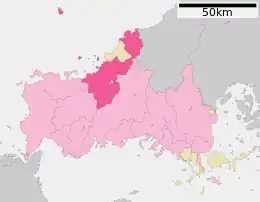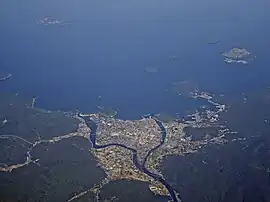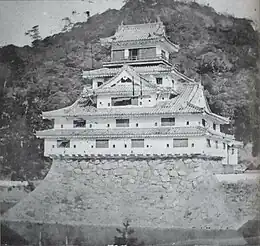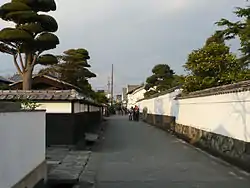Hagi, Yamaguchi
Hagi (萩市, Hagi-shi) is a city located in Yamaguchi Prefecture, Japan. As of 30 April 2023, the city had an estimated population of 43,233 in 22,803 households and a population density of 62 persons per km².[1] The total area of the city is 698.31 square kilometres (269.62 sq mi). It is known for being the birthplace of Hagi ware, a type of Japanese pottery.
Hagi
萩市 | |
|---|---|
 Flag  Emblem | |
Location of Hagi in Yamaguchi Prefecture | |
 | |
 Hagi Location in Japan | |
| Coordinates: 34°24′29″N 131°23′57″E | |
| Country | Japan |
| Region | Chūgoku (San'yō) |
| Prefecture | Yamaguchi |
| Hagi Town | April 1, 1889 |
| Hagi City | July 1, 1932 |
| Government | |
| • Mayor | Fumihito Tanaka (from May 2021) |
| Area | |
| • Total | 698.31 km2 (269.62 sq mi) |
| Population (April 30, 2023) | |
| • Total | 43,233 |
| • Density | 62/km2 (160/sq mi) |
| Time zone | UTC+09:00 (JST) |
| City hall address | 510 Emukai, Hagi-shi, Yamaguchi-ken 758-8555 |
| Climate | Cfa |
| Website | Official website |
| Symbols | |
| Flower | Camellia japonica and Lespedeza |
| Fruit | Natsumikan |
| Tree | Chamaecyparis obtusa and Pine |


Geography
Facing the Sea of Japan on one side and being surrounded by mountains on three sides, the center of Hagi is located on one of the largest delta areas in Japan. The Abu River splits into two, forming the Hashimoto River and the Matsumoto River. Outlying islands include Mishima, Oshima, Aishima, Hitsushima, Hashima, Hisima, and Oshima. of which Ainoshima and Hitsushima are inhabited.
Climate
Hagi has a humid subtropical climate (Köppen Cfa) with hot, humid and wet summers combined with cool to mild winters, with a relatively high precipitation amount compared to mainland Asian locations on similar latitudes.
| Climate data for Hagi (1991−2020 normals, extremes 1948−present) | |||||||||||||
|---|---|---|---|---|---|---|---|---|---|---|---|---|---|
| Month | Jan | Feb | Mar | Apr | May | Jun | Jul | Aug | Sep | Oct | Nov | Dec | Year |
| Record high °C (°F) | 18.8 (65.8) |
23.6 (74.5) |
25.9 (78.6) |
30.7 (87.3) |
32.1 (89.8) |
34.6 (94.3) |
36.6 (97.9) |
38.3 (100.9) |
37.4 (99.3) |
32.2 (90.0) |
26.5 (79.7) |
24.2 (75.6) |
38.3 (100.9) |
| Average high °C (°F) | 9.4 (48.9) |
10.4 (50.7) |
13.7 (56.7) |
18.4 (65.1) |
22.9 (73.2) |
25.7 (78.3) |
30.1 (86.2) |
31.1 (88.0) |
27.2 (81.0) |
22.4 (72.3) |
17.3 (63.1) |
11.8 (53.2) |
20.0 (68.1) |
| Daily mean °C (°F) | 5.7 (42.3) |
6.4 (43.5) |
9.1 (48.4) |
13.6 (56.5) |
18.3 (64.9) |
21.9 (71.4) |
26.2 (79.2) |
27.0 (80.6) |
23.1 (73.6) |
17.7 (63.9) |
12.8 (55.0) |
8.0 (46.4) |
15.8 (60.5) |
| Average low °C (°F) | 2.4 (36.3) |
2.5 (36.5) |
4.6 (40.3) |
8.8 (47.8) |
13.9 (57.0) |
18.6 (65.5) |
23.0 (73.4) |
23.8 (74.8) |
19.8 (67.6) |
13.7 (56.7) |
8.6 (47.5) |
4.3 (39.7) |
12.0 (53.6) |
| Record low °C (°F) | −5.8 (21.6) |
−6.8 (19.8) |
−3.9 (25.0) |
−0.3 (31.5) |
3.0 (37.4) |
8.6 (47.5) |
12.2 (54.0) |
15.2 (59.4) |
8.1 (46.6) |
3.9 (39.0) |
0.6 (33.1) |
−3.8 (25.2) |
−6.8 (19.8) |
| Average precipitation mm (inches) | 94.5 (3.72) |
76.3 (3.00) |
124.5 (4.90) |
120.4 (4.74) |
134.7 (5.30) |
206.5 (8.13) |
273.5 (10.77) |
178.0 (7.01) |
201.4 (7.93) |
107.5 (4.23) |
88.8 (3.50) |
86.9 (3.42) |
1,692.9 (66.65) |
| Average snowfall cm (inches) | 3 (1.2) |
2 (0.8) |
0 (0) |
0 (0) |
0 (0) |
0 (0) |
0 (0) |
0 (0) |
0 (0) |
0 (0) |
0 (0) |
trace | 5 (2.0) |
| Average precipitation days (≥ 1.0 mm) | 10.8 | 10.2 | 11.5 | 10.1 | 8.7 | 11.4 | 10.7 | 9.0 | 10.2 | 8.1 | 8.9 | 10.6 | 120.2 |
| Average snowy days (≥ 1 cm) | 0.9 | 0.6 | 0 | 0 | 0 | 0 | 0 | 0 | 0 | 0 | 0 | 0.2 | 1.7 |
| Average relative humidity (%) | 70 | 69 | 69 | 70 | 71 | 80 | 78 | 78 | 79 | 76 | 73 | 71 | 74 |
| Mean monthly sunshine hours | 76.6 | 94.4 | 147.3 | 177.4 | 204.6 | 139.1 | 171.8 | 206.3 | 152.4 | 160.8 | 119.2 | 83.3 | 1,733.2 |
| Source: Japan Meteorological Agency[2][3][4] | |||||||||||||
| Climate data for Susa, Hagi (1991−2020 normals, extremes 1977−present) | |||||||||||||
|---|---|---|---|---|---|---|---|---|---|---|---|---|---|
| Month | Jan | Feb | Mar | Apr | May | Jun | Jul | Aug | Sep | Oct | Nov | Dec | Year |
| Record high °C (°F) | 19.5 (67.1) |
22.9 (73.2) |
25.0 (77.0) |
30.0 (86.0) |
30.9 (87.6) |
33.7 (92.7) |
36.2 (97.2) |
37.3 (99.1) |
35.5 (95.9) |
32.0 (89.6) |
26.1 (79.0) |
24.4 (75.9) |
37.3 (99.1) |
| Average high °C (°F) | 8.9 (48.0) |
9.8 (49.6) |
12.9 (55.2) |
17.8 (64.0) |
22.4 (72.3) |
25.3 (77.5) |
29.2 (84.6) |
30.6 (87.1) |
26.5 (79.7) |
21.7 (71.1) |
16.7 (62.1) |
11.4 (52.5) |
19.4 (67.0) |
| Daily mean °C (°F) | 5.1 (41.2) |
5.4 (41.7) |
8.0 (46.4) |
12.6 (54.7) |
17.2 (63.0) |
21.0 (69.8) |
25.2 (77.4) |
26.0 (78.8) |
21.9 (71.4) |
16.4 (61.5) |
11.6 (52.9) |
7.1 (44.8) |
14.8 (58.6) |
| Average low °C (°F) | 0.9 (33.6) |
0.6 (33.1) |
2.4 (36.3) |
6.6 (43.9) |
11.6 (52.9) |
16.9 (62.4) |
21.6 (70.9) |
22.1 (71.8) |
17.7 (63.9) |
11.3 (52.3) |
6.4 (43.5) |
2.6 (36.7) |
10.1 (50.1) |
| Record low °C (°F) | −6.2 (20.8) |
−7.1 (19.2) |
−4.8 (23.4) |
−2.9 (26.8) |
1.1 (34.0) |
6.5 (43.7) |
12.6 (54.7) |
14.9 (58.8) |
7.1 (44.8) |
2.2 (36.0) |
−2.3 (27.9) |
−3.7 (25.3) |
−7.1 (19.2) |
| Average precipitation mm (inches) | 102.8 (4.05) |
85.8 (3.38) |
137.1 (5.40) |
124.7 (4.91) |
142.2 (5.60) |
209.1 (8.23) |
274.2 (10.80) |
164.8 (6.49) |
208.0 (8.19) |
117.3 (4.62) |
102.7 (4.04) |
107.9 (4.25) |
1,776.6 (69.94) |
| Average precipitation days (≥ 1.0 mm) | 12.8 | 11.5 | 12.5 | 10.7 | 9.7 | 11.7 | 11.3 | 9.0 | 10.7 | 9.4 | 10.9 | 12.7 | 132.9 |
| Mean monthly sunshine hours | 66.8 | 88.5 | 146.7 | 183.6 | 206.9 | 144.7 | 173.7 | 203.8 | 148.9 | 157.4 | 111.3 | 72.2 | 1,704.6 |
| Source: Japan Meteorological Agency[5][6] | |||||||||||||
Population
One of the factors underlying the continual decrease of population is said to be its poor public transport. Industry did not grow at all and the rapid economic growth of Japan only caused the town to decline. But it also kept the traditions alive and the traditional look of the town preserved.
| Year | Pop. | ±% p.a. |
|---|---|---|
| 1955 | 97,744 | — |
| 1960 | 93,245 | −0.94% |
| 1970 | 77,962 | −1.77% |
| 1980 | 74,846 | −0.41% |
| 1990 | 68,999 | −0.81% |
| 1995 | 65,293 | −1.10% |
| 2000 | 61,745 | −1.11% |
| 2005 | 57,989 | −1.25% |
| 2010 | 53,606 | −1.56% |
| Source: [7] | ||
History
The area of Hagi was part of ancient Nagato Province. During the [[Muromachi period, the Yoshimi clan built a minor fortification at a fishing village where the city is now located. During the Edo Period, the area was the center of Chōshū Domain, with the Mōri clan ruling as daimyō from their stronghold at Hagi Castle for 250 years. The samurai of Chōshū Domain played a major role in the Meiji restoration of the 1860s, and many leaders of the Meiji government came from this city. The Hagi Rebellion of 1876 was staged by former samurai unhappy with the changes to their status under the new regime. The town of Hagi within Abu District, Yamaguchi was established on April 1, 1889 with the creation of the modern municipalities system. Hagi was raised to city status on July 1, 1932.
On March 6, 2005, Hagi absorbed the towns of Susa and Tamagawa, and the villages of Asahi, Fukue, Kawakami and Mutsumi (all from Abu District) to create the new, expanded city of Hagi.
Government
Hagi has a mayor-council form of government with a directly elected mayor and a unicameral city council of 20 members. Hagi, collectively with the town of Abu, contributes two members to the Yamaguchi Prefectural Assembly. In terms of national politics, the city is part of the Yamaguchi 3rd district of the lower house of the Diet of Japan.
Military
Hagi is home to the Ground Self-Defense Force's Mutsumi Training Area, and is a proposed installation site for the Aegis Ashore missile defense system.[8]
Economy
The main industries in Hagi are tourism, agriculture and commercial fishing. Industrial development has been greatly hampered by poor transportation and logistics connections, although a number of industrial parks have been established.
Education

Hagi has 20 public elementary schools and 14 public junior high schools operated by the city government, and two public high schools operated by the Yamaguchi Prefectural Board of Education. There are also one private junior high school and one private high school. The prefecture also operated one special education school for the handicapped. The Yamaguchi University of Human Welfare and Culture is located in Hagi.
Transportation
The development of the transportation network in Hagi is the slowest in Yamaguchi Prefecture, and access to Shinkansen, expressway networks, and airports is particularly inconvenient. The nearest Shinkansen station, Shin-Yamaguchi is about an hour away by bus, and the nearest airport, Iwami Airport in Masuda, Shimane Prefecture is also an hour away.
Railway
![]() JR West (JR West) - San'in Main Line
JR West (JR West) - San'in Main Line
Local attractions
Hagi Pottery (Hagiyaki)
Hagi is renowned for Hagi ware, a form of Japanese pottery dating from 1604 when two Korean potters were brought to Hagi by Mōri Terumoto.
Sister city relations
.svg.png.webp) - Ulsan, South Korea, since 1968.
- Ulsan, South Korea, since 1968.
Noted people from Hagi
- Yoshida Shōin (1830-1859), intellectual, teacher and revolutionary
- Inoue Masaru, known as the "Father of the Japanese Railways".
- Katsura Taro, former prime minister of Japan.
- Kido Takayoshi
- Omura Masujiro
- Takasugi Shinsaku
- Tanaka Giichi, former prime minister of Japan.
- Yamagata Aritomo, former prime minister of Japan.
References
- "Hagi City official statistics" (in Japanese). Japan.
- "平年値(年・月ごとの値)". Japan Meteorological Agency. Retrieved 2011-10-07.
- "観測史上1~10位の値(年間を通じての値)". Japan Meteorological Agency. Retrieved 2011-10-07.
- "47754: Hagi (Japan)". ogimet.com. OGIMET. 22 June 2022. Retrieved 23 June 2022.
- 気象庁 / 平年値(年・月ごとの値). JMA. Retrieved May 27, 2022.
- 観測史上1~10位の値(年間を通じての値). JMA. Retrieved May 27, 2022.
- National Census by Statistics Bureau Japan
- The Associated Press (June 23, 2018). "Japan's defence chief seeks local support to deploy a land-based missile shield". The South China Morning Post.
Further reading
- Gregg, N. Taylor (June 1984). "Hagi: Where Japan's Revolution Began". National Geographic. Vol. 165, no. 6. pp. 751–773. ISSN 0027-9358. OCLC 643483454.
External links
- HAGI Sightseeing Guide (tourism website run by Hagi Tourism Association) (English)
- Hagi City official website (in Japanese)
 Hagi travel guide from Wikivoyage
Hagi travel guide from Wikivoyage Geographic data related to Hagi, Yamaguchi at OpenStreetMap
Geographic data related to Hagi, Yamaguchi at OpenStreetMap




